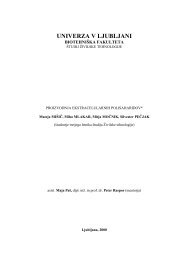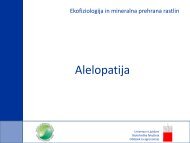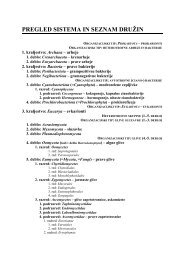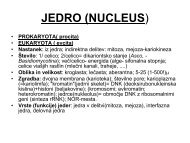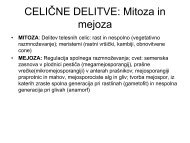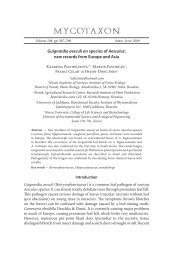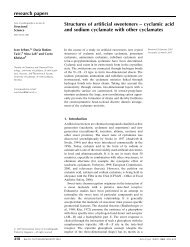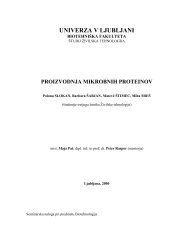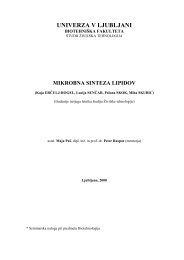Bryophytes
Bryophytes
Bryophytes
Create successful ePaper yourself
Turn your PDF publications into a flip-book with our unique Google optimized e-Paper software.
An introduction to<br />
bryophyte biology<br />
Dr. Marko SABOVLJEVIĆ<br />
Institute of Botany and Garden,<br />
Faculty of Biology, University of Belgrade<br />
Serbia<br />
marko@bio.bg.ac.rs
<strong>Bryophytes</strong><br />
- the second largest group of terrestrial plants<br />
(15000-25000)<br />
- very heterogeneous group of paraphyletic origin<br />
- their ancestor were among the first land plant<br />
Amphibians among<br />
land plants
Overview of land plant evolution<br />
Four main groups of land plants<br />
<strong>Bryophytes</strong><br />
•Pteridophytes<br />
•Gymnosperms<br />
and<br />
•Angiosperms<br />
Groups are distinguished from algae by reproduction (life<br />
cycle) that involves the development of a multi-cellular<br />
embryo attached to the mother plant for its protection and<br />
nourishment.
<strong>Bryophytes</strong> – liverworts, hornworts, mosses<br />
- <strong>Bryophytes</strong> have no vascular tissues.<br />
- The rest three groups are<br />
all vascular plants (tracheophytes).<br />
- Vascular plants have cells that are joined to produce<br />
tubes that transport water and nutrients throughout the<br />
plant.<br />
- <strong>Bryophytes</strong> live in damp/moist environments and are small<br />
due to not having vascular tissue. They are sometimes called<br />
non-vascular plants.
Alternation of generations<br />
Two multi-cellular body forms:<br />
a. Gametophyte (haploid) that<br />
produces gametes. Gametes<br />
fuse to form zygotes that<br />
develop into…<br />
b. Sporophytes (diploid) that<br />
produce spores. Spores are<br />
haploid cells that can develop<br />
into a new organism without<br />
fusing with another cell.
Spore walls contain sporopollenin<br />
a. Sporopollenin is a polymer that makes the walls of plant<br />
spores very tough and resistant to harsh conditions.<br />
b. Sporopollenin is the most durable organic material known.<br />
c. Spores are produced by<br />
sporangia (cells in the sporophyte)<br />
through the process of meiosis.<br />
d. Durable spores are an<br />
adaptation for surviving on land.<br />
•Can withstand long periods of adverse conditions.<br />
•Easily transported by wind and water.
Terms:<br />
<strong>Bryophytes</strong> (subkingdom Bryobiotina)<br />
include phylla:<br />
- Mosses (Bryophyta)<br />
- Hornworts (Antocerotophyta)<br />
- Liverworts (Marchantiophyta)<br />
- haircup mosses(Polytricho-phyta/psida)<br />
- peat mosses(Spagno-phyta/psida)<br />
- lantern (Andreaeao-phyta/psida)<br />
- takakia mosses (Takakio-phyta/psida)
<strong>Bryophytes</strong> – sensu lato<br />
Mosses<br />
Liverworts<br />
Hornworts<br />
ć
Scapania nemorea Plagiochila asplenioides<br />
Liverwort representatives<br />
m
Marchantiophyta - the Liverworts<br />
* So-called because the thallus of many liverworts resembles the<br />
lobes of a liver ”Doctrine of Signatures”<br />
* The Anglo-Saxon ending “wort” (originally wyrt) means “herb”<br />
* Liverworts lack conducting elements, a cuticle and stomata<br />
* The gametophyte can be “thallose” or “leafy” (Order<br />
Jungermanniales)<br />
Thallose<br />
liverwort -<br />
Riccia<br />
Leafy<br />
liverwort<br />
Mylia
Thallose Liverworts - Order MARCHANTIALES<br />
* The thallus usually has some internal differentiation in the<br />
form of photosynthetic cells, air chambers and storage<br />
tissues<br />
* The sporophyte is compact, with no seta (stalk) or a short<br />
one<br />
* The capsule (sporangium) has a single-layered wall
Ricciocarpus natans<br />
This liverwort is amphibious and grows readily in laboratory<br />
culture.<br />
Floating thalli of Ricciocarpus<br />
4<br />
3. Thallus from above showing ventral<br />
scales and dorsal furrow<br />
4. Ventral scale<br />
3
Ricciocarpus - the Dorsal Furrow<br />
Antheridium<br />
Storage<br />
tissue<br />
Dorsal furrow<br />
Closeup of Dorsal<br />
Ventral scales<br />
Furrow and Ventral<br />
Scales Section in Region of<br />
Dichotomy<br />
Air<br />
Chamber
Ricciocarpus - Air Chambers and Rhizoids<br />
Pattern of Air Chambers from<br />
Above<br />
Section showing Air Chambers and Rhizoids<br />
Pore from Above Pore in Section
Ricciocarpus - Gametangia<br />
* Gametangia only occur in floating plants<br />
* Gametangia are sunken within the dorsal furrows<br />
* Antheridia and archegonia occur on the same plants (i.e. the<br />
plants are monoecious)<br />
* Antheridia appear before the archegonia (i.e. the plants are<br />
protandrous)<br />
sp. = spermatogenous tissue<br />
s.j.=sterile jacket<br />
s =stalk<br />
Egg<br />
Antheridium, l.s. Archegonium, l.s.<br />
Neck cell<br />
Neck canal cell<br />
Ventral canal cell<br />
Venter
Ricciocarpus - Sporophyte and Sporangium Development<br />
* The sporophyte develops within the gametophyte tissues<br />
* The archegonial tissue growth keeps pace to form a calyptra<br />
Endothecium<br />
Calyptra<br />
Amphithecium<br />
Longitudinal Section of developing<br />
sporophyte<br />
Section of sporophytes with spore<br />
tetrads (n.b. lack of mechanism<br />
for spore dissemination)
Riccia<br />
* Most species of Riccia are terrestrial, but Riccia fluitans is<br />
amphibious<br />
Habit Section of thallus<br />
Riccia fluitans (floating)<br />
Note large<br />
air chambers<br />
Top left - spore<br />
Bottom left - epidermal<br />
and photosynthetic cells<br />
Top right - sporophyte<br />
with tetrads<br />
Bottom right - habit<br />
Riccia glauca (terrestrial)<br />
Air spaces are narrow and slit-like
Marchantia polymorpha<br />
1. Female plant with archegoniophores<br />
2. Male plant with antheridiophores<br />
3. Gemmae cups<br />
4. Dorsal surface of thallus showing air<br />
chamber outlines and pores
Marchantia - thallus structure<br />
Pore<br />
Scale Rhizoids<br />
Pores<br />
Rhizoids Storage tissue<br />
Drawing of cross-section Photomicrograph of cross-section<br />
Photosynthetic<br />
tissue
Marchantia - Asexual Reproduction by<br />
Gemmae<br />
Gemma cups on dorsal surface<br />
n.b. these are “splash cups”<br />
Single gemma, with<br />
its two meristems<br />
Longitudinal section through gemma cup<br />
Gemmae
Thallose Liverworts - Order METZGERIALES<br />
* Lack air chambers, pores, ventral scales<br />
* Gametangia and sporophytes are sessile on the gametophyte<br />
* Elevation of the capsule (sporangium) is accomplished by<br />
elongation of the seta (stalk) of the sporophyte<br />
* Sporangia contain elaters<br />
Pellia thallus from<br />
above<br />
Antheridia are<br />
submerged in a<br />
central position,<br />
protected by a<br />
mound-like layer of<br />
cells with a pore<br />
Archegonia occur<br />
nearer the apex under<br />
a flap-like involucre<br />
Thallus with<br />
sporophyte
Succubous<br />
(Plagiochila)<br />
Leafy Liverworts - Order JUNGERMANNIALES<br />
* The largest order of liverworts (7500 species)<br />
* Dorsiventral growth habit<br />
•Two rows of lateral leaves<br />
and one row of ventral leaves (amphigastria)<br />
* Two manners of overlap of lateral leaves - incubous or<br />
succubous (the latter being like shingles on a roof)<br />
* Usually in conditions of high humidity<br />
Incubous<br />
(Bazzania)<br />
Leafy liverwort epiphytic on leaf of<br />
rainforest tree in Amazon basin
Calypogeia fissa, showing<br />
underleaves and rhizoids<br />
Underleaves, Rhizoids and Leaf Lobing<br />
Diplophyllum albicans,<br />
showing bilobed dorsal<br />
leaves<br />
Scapania nemorea, showing bilobed<br />
dorsal leaves<br />
Belpharostoma trichophyllum,<br />
showing trichophyllous leaves
Asexual Reproduction in Leafy Liverworts<br />
Gemmae of Barbilophozia hatcherii
Sexual Reproduction in Leafy Liverworts<br />
* Most leafy liverworts are dioecious<br />
* Antheridia and archegonia are formed on short side-branches<br />
* The seta of the sporophyte undergoes elongation at maturity<br />
* Elaters are present in the sporangium<br />
* Sporangium dehiscence usually occurs along four vertical<br />
rows of thin-walled cells
Sporophyte Form and Dehiscence in Leafy Liverworts<br />
Radula, showing (1) sporophyte<br />
and (4) gemmae<br />
Scapania, showing<br />
dehisced sporangium
Phaeoceros sp.<br />
Anthoceros sp.<br />
Notothylas sp.<br />
Nees-Institut für Biodiversität der Pflanzen<br />
Hornworts representatives
ANTHOCEROPHYTA - the Hornworts<br />
Hornworts are separated from the liverworts on the basis that:<br />
* The sporophyte is shaped like a tapered horn<br />
* The sporophyte has an intercalary meristem, so can grow<br />
indeterminately<br />
* The thallus has stoma-like structures, the only known<br />
occurrence in a gametophyte<br />
* Each photosynthetic cell contains a<br />
single chloroplast<br />
*Archegonia are embedded in the thallus<br />
and in contact with surrounding vegetative<br />
cells<br />
* Cavities are filled with mucilage<br />
containing Nostoc
Sexual Reproduction in the Hornworts<br />
Young antheridium in<br />
antheridial chamber<br />
Longitudinal section through<br />
archegonium. n.b. single lenticular<br />
chloroplast in each cell
Dehiscence<br />
The Hornwort Sporophyte<br />
Longitudinal section of<br />
sporophyte<br />
s - spore<br />
Pseudo-elaters<br />
c - columella<br />
t - tetrad<br />
sp - sporocyte<br />
i - involucre<br />
g - gametophyte<br />
f - foot<br />
m - meristematic zone<br />
s.t. - sporogenous tract
Sporophyte<br />
Spores<br />
Mature<br />
sporangium<br />
splits open<br />
Gametophyte with<br />
embedded archegonia<br />
and antheridia<br />
Fig. 22-11b, p. 441
Mosses<br />
• Leafy moss gametophytes develop from a protonema<br />
• A moss sporophyte consists of a capsule, a seta, and a foot
Capsule<br />
Seta<br />
Foot
• PROTONEMA<br />
KEY TERMS<br />
– In mosses, a filament of n cells that grows<br />
from a spore and develops into leafy moss<br />
gametophytes<br />
• CAPSULE<br />
– Portion of the bryophyte sporophyte in which<br />
spores are produced
Mosses
Life Cycle: Mosses
Characteristics<br />
• Chlorophyll a, Starch, Cellulose<br />
• No lignin<br />
• Usually no conductive tissue, sometimes<br />
poorly developed tissue<br />
• Gametophyte dominant, perennial<br />
• Sporophyte parasitic on gametophyte<br />
• NEED MOIST ENVIRONMENT, when<br />
active
Sex!<br />
• Sperm swim from antheridia<br />
into archegonia and fertilize<br />
egg<br />
• Sporophyte grows out of<br />
archegonium<br />
Antheridia<br />
Archegonia,<br />
with egg
Moss gametophytes<br />
• Rhizoids,<br />
Cauloids,<br />
Phylloids<br />
• Leaves 3-ranked<br />
• Leaves not lobed,<br />
mostly 1 cell thick<br />
• Leaves often with<br />
costa<br />
teeth<br />
Hairy calyptras
Moss Sporophyte<br />
• Persistent<br />
• Seta + capsule<br />
• Capsule has:<br />
– Sporangium<br />
– Peristome teeth<br />
– Operculum<br />
• Covered by calyptra<br />
– Calyptra = Top of<br />
archegonium<br />
teeth<br />
Peristome<br />
teeth<br />
Hairy calyptras
Peat mosses
Haircup mosses
Latern mosses
Genuine mosses
Acrocarpous vs. pleurocarpous mosses
While the moss sporophyte does have<br />
photosynthetic plastids, they cannot live apart<br />
from the maternal gametophyte.<br />
A moss sporophyte remains attached to its<br />
parental gametophyte throughout the<br />
sporophyte’s lifetime.<br />
It depends on the gametophyte for sugars,<br />
amino acids, minerals and water.<br />
<strong>Bryophytes</strong> have the smallest and simplest<br />
sporophytes of all modern plant groups.
mosses
<strong>Bryophytes</strong> provide many ecological<br />
and economic benefits<br />
• Wind dispersal of lightweight spores has<br />
distributed bryophytes around the world.<br />
• They are common and diverse in moist<br />
forests and wetlands.<br />
• Some even inhabit extreme environments<br />
like mountaintops, sea-shores and<br />
deserts.<br />
– Mosses can loose most of their body water<br />
and then rehydrate and reactivate their cells<br />
when moisture again becomes available.
Ecological and economic benefits of bryophytes<br />
1. <strong>Bryophytes</strong> were the world’s only plants for 100 million<br />
years.<br />
2. Peat bogs are made mostly of moss called<br />
Sphagnum. They contain 400 billion tons of carbon and cut<br />
down the amount of greenhouse gases. Peat is harvested,<br />
dried, and used as a fuel.<br />
3. Sphagnum is harvested for use as a soil conditioner and<br />
plant packing material.
Sphagnum, or peat moss
Bryophyte features<br />
one set of chromosomes dictates its appearance and function<br />
it means<br />
small changes in the environment can be epigenetically easily<br />
expressed
- poikilohydric<br />
Syntrichia ruralis<br />
- ectohydric/endohydric
<strong>Bryophytes</strong><br />
are used in biotechnological<br />
processes in quite a few cases<br />
but they have a huge potentials
Bryophyte potentials:<br />
- new chemical compunds<br />
- biological activity<br />
- fitoterapy<br />
- AIDS and cancer?<br />
- bioindicators, microdust reduction<br />
(static electricity)<br />
- ecosystem restauration, improvement and restauration of<br />
human environment<br />
- Biopesticides, -insecticids, moluscicids, biorapelents...
Disadvantages:<br />
- not enough monotypic<br />
axenic materials<br />
- in vitro establishment<br />
- low level of knowledge<br />
on bryophyte biology<br />
- endobionts<br />
…
Monoculture?
Advantages I:<br />
- small plants, easy to manipulate (money, space)<br />
- dominant haploid phases (high ratio of homologous<br />
recombination)<br />
- Single gene knockout (gene function not covered by counterpart<br />
allele)<br />
- Gene targeting (mosses integrate transformed DNA with high<br />
frequency due to high level of hom. recombination)<br />
- Complete genome sequenced (Physcomitrella patens), partly<br />
(Marchantia polymorpha)<br />
- genetic pool – for the crop plant modification (stress support)
Advantages II:<br />
- Molecular farming and metaboloc engineering<br />
- cure, medicines, and pharmaceutical products naturally<br />
sintetized in plants (moss bioreactors)<br />
- cryoconservation<br />
-small size of plants<br />
(easier control of<br />
potential GMO runaway)
Bryopyte Ecology<br />
- all world ecosystems except seas<br />
- the hugest biomass in tundras and<br />
rain forests<br />
- microhabitats
Moss Cation Exchange Capacity<br />
- a fenomena in mosses<br />
- high degree to which a moss can adsorb<br />
and exchange cations
ppm<br />
18000<br />
16500<br />
15000<br />
13500<br />
12000<br />
10500<br />
9000<br />
7500<br />
6000<br />
4500<br />
3000<br />
1500<br />
1250<br />
1000<br />
750<br />
500<br />
250<br />
0<br />
Bryum capillare<br />
Ceratodon purpureus<br />
substrate<br />
Fe Mn Zn Pb Ni Cd Cu<br />
Heavy metal content in mosses and in<br />
substrate (ppm).
PbCl2 + 2 KCr2O7 → 2 KCl + PbCr2O7 ↓ (green-yellow soot)<br />
BaCl2 + 2 KCr2O7 → 2 KCl + BaCr2O7 ↓ (orange-yellow soot)<br />
m
ć<br />
m
ć<br />
m
Indication
Indicators – lead moss<br />
Ditrichum plumbicola
Indicators –<br />
Copper moss
Entosthodon hungaricus<br />
salinity indicator
Entosthodon hungaricus
Entosthodon hungaricus
Entosthodon hungaricus<br />
apogamy
Signal species
Bruchia vogesiaca
ć<br />
m
ć<br />
m
ć<br />
m
Ecosystem restorations<br />
ć
ć<br />
m
ć<br />
m
ć<br />
m
Laboratory<br />
and field<br />
experiments
• in vitro studies
Alelopathy<br />
- Chemical contents<br />
- Bioactive components
Sphagnum palustre
German population of Dichelyma capillaceum<br />
2005 2009<br />
2012? 2020??
THANK YOU FOR ATTENTION




